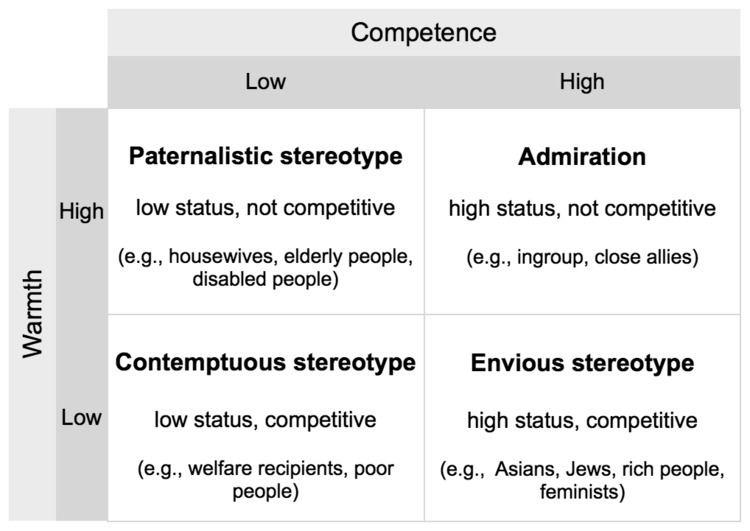 | ||
The stereotype content model (SCM) is a psychological theory that hypothesizes that stereotypes possess two dimensions: warmth and competence. Social groups are perceived as warm if they do not compete with the ingroup for the same resources (e.g., college space) and they are considered competent if they are high in status (e.g., economically or educationally successful). Thus, lack of competition predicts perceived warmth and status predicts perceived competence. The model was first proposed by social psychologist Susan Fiske and her colleagues Amy Cuddy, Peter Glick and Jun Xu.
Contents
Dimensions
The SCM postulates that all social groups (e.g., older people, the homeless, drug addicts) fit within each of the four combinations of high and low levels of warmth and competence. Contradicting earlier theories of stereotype content which assumed that stereotypes reflected unidimensional and uniformly negative attitudes, the stereotype content model theorizes that stereotypes are often mixed or ambivalent: groups perceived to be high in one dimension, but low in the other (e.g., old people as rated high on warmth, but low on competence). The groups within each of the four combinations of high and low levels of warmth and competence elicit distinct emotions:
- Noncompetitive, low-status outgroups are perceived as warm but incompetent (e.g., housewives, disabled and older people) and are usually liked and pitied but disrespected.
- Feelings of pride and admiration are aroused by groups considered both competent and warm (e.g., the ingroup, close allies).
- Groups regarded as incompetent and not warm (e.g., welfare recipients, poor people) elicit feelings of contempt and pity.
- High-status, competitive outgroups are perceived as high on competence but low on warmth (e.g., Asians, Jews, feminists, rich people) and are subject to an envious stereotype which is accompanied by feelings of admiration and resentment.
The ingroup, i.e., the group to which an observer personally belongs, close allies, and societal reference groups (e.g., cultural default groups such as the middle class, heterosexuals) tend to be rated as high on both dimensions. However, there are differences between ingroup perceptions between Western and Eastern cultures, with only Western cultures displaying this ingroup favoritism.
The stereotype content model was empirically tested on a variety of national and international samples and was found to reliably predict stereotype content in different cultural contexts and affective reactions toward a variety of different groups. The model has also received support in such domains as interpersonal perception.
Behavioral outcomes
The SCM posits that intergroup emotions and stereotypes predict distinct behaviors which can be active, passive, facilitative, and harmful. Active behaviors require effort and engagement (e.g., help or attack) whereas passive behaviors impact the target group either positively or negatively but require less exertion (e.g., passive association or neglect). Facilitative actions are intended to bring about favorable outcomes or gains for a group while harmful behaviors are intended to produce detrimental outcomes or losses.
Admired groups judged as both warm and competent (e.g., the in-group) elicit the desire to assist them and associate with them (active and passive facilitation). By contrast, groups which are regarded as low in both warmth and competence are harmed passively or actively, that is, they are ignored or attacked. An example of this behavior would be avoiding eye contact with or harassing a homeless person. Pitied groups considered warm but incompetent elicit active helping or passive neglect. Disabled people, for example, may sometimes be neglected and other times patronized and offered too much help. Envied groups judged as competent elicit active harm and passive association. For example, one might choose to work with a member of a group assumed to be very competent (e.g., Asian or Jewish) on a math project but otherwise dislike that groups and seek to actively harm it.
Implicit stereotypes
So far most researchers in this area have relied on explicit measures of stereotypes (i.e., self-reports). In fact, there have been very few attempts to systematically study mixed stereotype content with implicit measures. Implicit measures have two main qualities that make them important complements to traditional explicit measures of stereotypes. First, implicit measures are much less susceptible to social desirability bias. Second, implicit measures may tap biases that people cannot accurately identify by means of normal introspection and thus cannot express explicitly even if they are truly motivated to do so. Hence, implicit measures may prove to be valuable tools in the study of mixed stereotype content as predicted by the CSM. Using the implicit-association test, Carlsson and Björklund (2010) demonstrated the existence of implicit mixed stereotypes of two occupational groups, preschool teachers and lawyers. The former were considered warm but incompetent whereas the latter where regarded as cold and competent.
